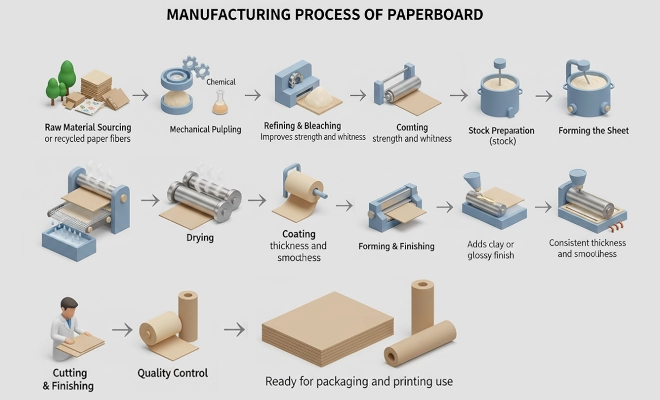Paperboard is a thick paper material that is stronger and durable than regular paper. It is usually more than 0.3 mm thick. It is made from wood pulp or recycled fibers. Even though it is light in weight, it is still sturdy. Paperboard is widely used for packaging because it can protect products and is easy to cut, fold, and print on. It is typically used for boxes, cartons, and packaging containers.
History of Paperboard
The history of paperboard goes back to 1817, when the first paperboard box was made in England. By the late 1800s, it had become widely used in the U.S. and Europe for packaging consumer goods like soap, tobacco, and cereals. In 1879, Robert Gair’s invention of the folding carton changed the industry by allowing mass production of pre-cut, pre-folded boxes.
During the 20th century, advancements in technology improved paperboard’s strength, printability, and versatility, leading to the development of coated and multi-layer types such as SBS and CRB. Today, paperboard remains an important material in sustainable packaging, offering an eco-friendly alternative to plastic.
Types of Paperboard
Solid Bleached Sulfate (SBS)
It is made from bleached virgin wood pulp that is white on all sides and offers a smooth surface for high-quality printing. Commonly used for cosmetic boxes and medical packaging.
Coated Unbleached Kraft (CUK)
It is made from unbleached wood pulp and is usually brown or grey. It is strong and durable. Often used for beverage carriers and food packaging.
Coated Recycled Board (CRB)
It is produced from recycled fibers, also called White-Lined Chipboard (WLC). It is cost-effective and eco-friendly, used for cereal boxes and dry food packaging.
Chipboard (Greyboard)
It is made from 100% recycled paper and is usually grey or brown in color. Commonly used for notepad backings and rigid boxes.
Folding Boxboard (FBB)
It is built with multiple layers and a bleached top layer. It is also lightweight and foldable. Commonly used for frozen food and pharmaceutical packaging.
Manufacturing Process of Paperboard
Here’s a simple step-by-step process of manufacturing paperboard:

Raw Material Sourcing: Paperboard is made from virgin wood pulp or recycled paper fibers.
- Wood Pulp: Paperboard is often made from virgin wood pulp, sourced from softwood or hardwood trees. Softwood fibers add strength, while hardwood fibers improve smoothness.
- Recycled Pulp: Recycled paper fibers are also widely used, helping reduce waste and support eco-friendly production.
Pulping: The raw materials are turned into pulp using mechanical or chemical processes. This step breaks down the fibers for paperboard making.
- Mechanical Pulping: Wood is ground into fibers, keeping most of the original content. This method makes a rougher but bulkier pulp.
- Chemical Pulping: Chemicals like sodium hydroxide break down the wood into pulp. This process creates stronger and cleaner fibers for better paperboard quality.
Refining & Bleaching: The pulp is refined to make the fibers smoother and stronger. Bleaching is done to improve color and brightness.
- Refining: The pulp is processed further to improve bonding between fibers, giving paperboard more strength.
- Bleaching: Brightening elements are added to improve color, whiteness, and surface appearance.
Stock Preparation: The pulp is mixed with water and additives like starch or sizing. This creates a slurry called stock.
Forming the Sheet: The slurry is spread on a wire mesh, where water drains away. The fibers come together to form a wet paper sheet.
Drying: The wet sheet passes through heated rollers that remove moisture. This makes the sheet firm and solid.
Calendering: The paperboard is pressed and smoothed to control thickness. This step also improves surface quality and finish.
Coating: A coating, such as clay, may be applied to the surface. It helps with better printing and a smooth look.
Cutting & Finishing: The paperboard is cut into sheets or rolled into reels. It is then packed for shipping and use.
Quality Control: Each batch is checked for thickness, strength, and other standards. This ensures the paperboard meets industry requirements.
Conclusion
Paperboard is an important material used in many industries, especially in packaging. It is lightweight, strong, and easy to shape into different forms. Its smooth surface also makes it great for printing and branding. Since it can be recycled and is more eco-friendly than plastic, it supports sustainable packaging. Overall, paperboard is a smart and practical choice for both businesses and the environment.

